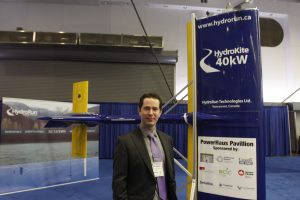By David Dodge and Duncan Kinney
GLOBE 2014 is the biggest business and sustainability conference in the nation and it happens every two years in Vancouver. Everyone from big oil to big green shows up and while a lot of time is spent debating the ins and outs of the transition to a clean energy future the most interesting part is totally removed from the flashy ballroom stage and the giant tradeshow floor.
Tucked in at the back of the tradeshow is the Grizzly Den. There 36 early stage companies pitch to a room full of people all of them looking for investors, partners or customers to help get them over the hump. We listened to every single pitch and we present three stories that caught our eye.
Hydrorun’s river powered drone

Joel Atwater is the chief technology officer for Hydrorun Technologies. Their Hydrokite invention flies in rivers generating electricity as the current rushes by creating lift over its wings. Photo Duncan Kinney, Green Energy Futures
Hydrorun Technologies got our attention with the Hydrokite. Even before their pitch they were noticeable with a full sized 40-kilowatt version of their product on the tradeshow floor. It’s large, blue and looks like a giant airplane wing placed on its side.
“It’s a drone that flies across the river, driven by the river’s flow. This generates a huge amount of lift, which pulls on a tether. That tether transmits the mechanical energy to a generation system which converts it to electricity and that electricity is transmitted to shore via a cable,” says Joel Atwater, the chief technology officer for Hydrorun.
The hydrokinetic power of our rivers is a massive, but unused resource. It’s often too slow to be used and logs and other debris can smash up an expensive turbine. The Hydrokite harvests that energy and claims it can dodge logs and other obstacles via onboard sensors and its intelligent systems. It’s an intriguing idea and their first 40-kilowatt pilot project will be installed later this year in the Fraser River in B.C. with a First Nations partner. They’re currently looking for early adopter customers and hope to roll out their product to the general market in 2016 or 2017.
Nomad Microhomes – Living in 100 square feet!

People step into the Nomad Microhome prototype on the trade show floor at GLOBE 2014. It’s 10×10 feet, is one and a half storeys tall and has all the comforts of a regular home. Photo Duncan Kinney, Green Energy Futures
We’ve covered smaller homes before on Green Energy Futures, but this takes small to a whole new level. The Nomad Microhome is a 100 square-foot (10 by 10 foot) home designed to have a very small footprint. It costs $28,000 for the base model.
The Nomad can be flat packed and shipped in a 20-foot shipping container at a very economical price. Nomad also claims it can be assembled by two people with handyman level skills in a couple of days.
Ian Kent is the founder and he has a background in the condo design industry. He’s sat in boardrooms with condo developers and marketers tweaking designs to come up with super efficient condo layouts. He’s taken that same approach and applied it to a tiny home.
There was a prototype assembled on the floor at GLOBE and it was a big hit as people clambered inside and upstairs this tiny modern home. It’s got a living room, kitchen, toilet and shower and the stairs are even integrated into the kitchen as shelves to save space. It’s one and a half stories tall and you can fit a double bed upstairs.
They’re manufactured in B.C. and they’ve been a big hit on the internet. They’re still early stage, looking for partners to help with marketing and building their production facility. It will take some time before you see Nomads in backyards but this will be very interesting company to follow.
Enterra Feed – Commercializing nature’s most prolific nutrient recycler

A handful of dried black soldier fly larvae from the folks at Enterra Feeds. It feeds on food waste and is sold as an ingredient in animal feed. Photo Duncan Kinney, Green Energy Futures
Feed bills itself as renewable food for animals and plants. The food production system uses entirely too much water, land and nutrients Enterra’s solution is to employ one of nature’s most prolific nutrient cyclers, the black soldier fly. It’s a bug that is native to North America and it doesn’t bite, sting or harbor any known diseases – all it does is eat.
Enterra takes pre-consumer food waste, typically fruits and veggies from grocery stores, and feeds them to black soldier fly larvae. They harvest the larvae and their waste and process it into ingredients for animal feed and organic fertilizer.
It is essentially a giant black soldier fly ranch. And the only waste from the process is the packaging the food waste comes in which is promptly recycled.
While a factory full of wriggling fly larvae might give you the heebie-jeebies it just might be a more sustainable way of feeding fish or chickens.
“It’s not as gross as you think, says Andrew Vickerson, Chief Technology Officer. “It’s all controlled, we have what are called bio-conversion units and then the flies themselves are in a completely different room which has its own environmental conditions. So it’s not a chaotic process, it’s actually quite controlled.”
But even Vickerson acknowledges that the first time you see it, you might be a little grossed out but says it’s no grosser than worm composting.

